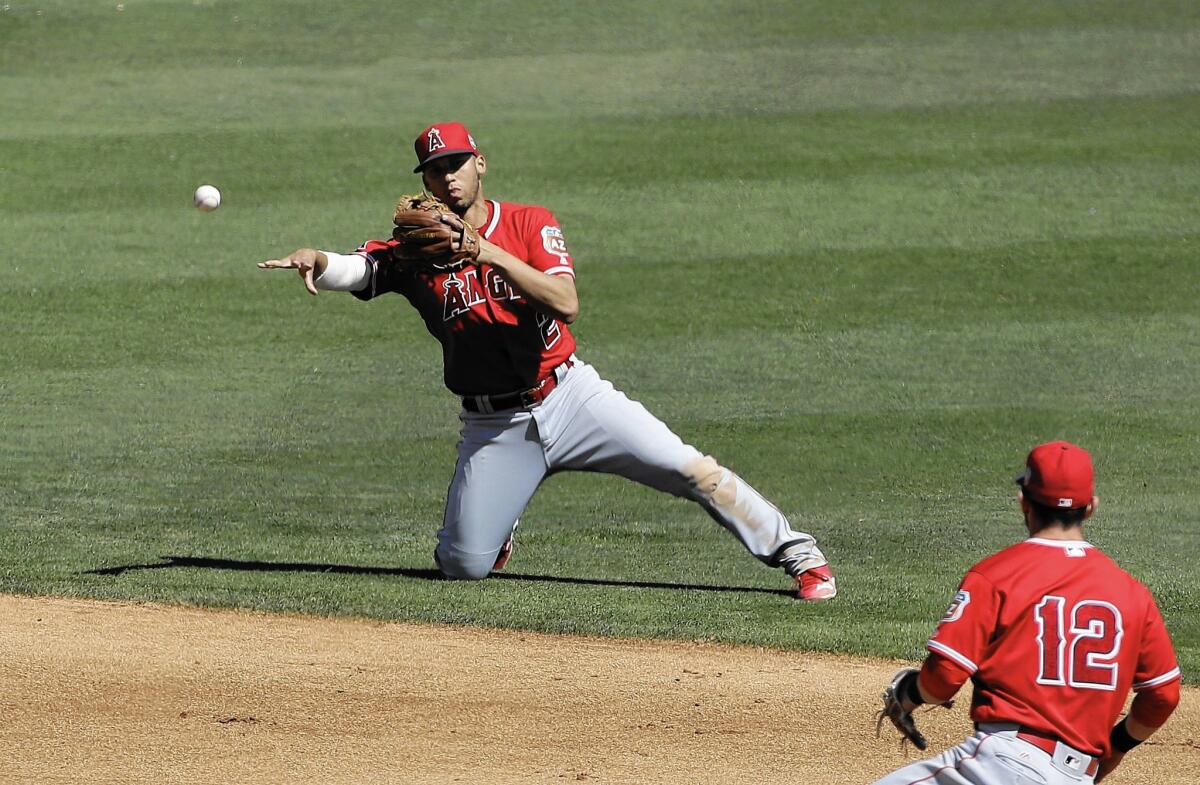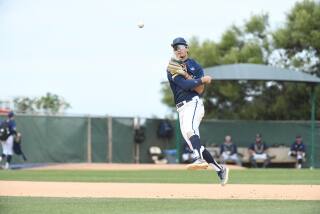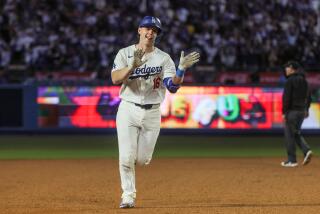The Angels’ Andrelton Simmons gets creative with the art of defense

- Share via
The coach was curious, so he shoved a bag of sunflower seeds into his pocket and caught the elevator down to the first floor of the Sunscape Resort in Willemstad, Curacao.
It was January 2009. That morning the coach had seen a young shortstop with rare defensive abilities.
Now he wondered if the kid could be taught to hit well enough that bringing him to the United States made sense.
In the lobby, 19-year-old Andrelton Simmons — all 145 pounds of him — was waiting with his father.

Pedro Moura and Lindsey Thiry discuss new Angels shortstop Andrelton Simmons’ defensive success, plus Manager Mike Scioscia and second baseman Johnny Giovetella explain why Simmons is considered the best defensive shortstop in baseball.
Kurt Russell ran the baseball team at Western Oklahoma State, a community college in a cow town of about 20,000 near the Texas border — about as far from the bright lights of a major league stadium as you can get on the college level. But a fair distance closer than Curacao.
He started the conversation with some small talk before honing in on what he really wanted.
“Hey, you got a bat in the car?” Russell asked. They did. “I’ve got some sunflower seeds. Let’s go to the parking lot and let me look at your bat path up close.”
For 45 minutes Russell tossed Simmons seeds, and Simmons swung with a downward tilt that Russell worked to flatten. When the lot was littered with shells, Russell made a pitch to Simmons’ father: Give me a chance to bulk up your kid and teach him how to hit, and his fielding will carry him far.
Three months later, Simmons was enrolled at Western Oklahoma State. Three years later, the Atlanta Braves called him up to the majors.
Simmons, 26 and about to start his first season with the Angels, is now regarded as the best defensive shortstop in the sport and arguably the best fielder at any position. He can perform the pantheon of spectacular defensive plays — jump throws, throws from the ground, deep relay throws, between-the-legs throws, between-the-legs tags, tags of bases while prostrate, running snares of fly balls and all sorts of slides that save him time getting off a throw.
One advanced defensive metric, known as Ultimate Zone Rating, pegs Simmons’ value over the past three seasons at 57 runs saved above the average shortstop. The next-best shortstop, Baltimore’s J.J. Hardy, is 30 runs behind.
But his college coach’s original question remains. Can he learn to hit?
The Angels think so. In November, they traded the top two pitching prospects in their organization in a deal for Simmons, whom they envision as a franchise cornerstone beside Mike Trout.
“He has really good plate discipline,” Angels General Manager Billy Eppler said. “… When he swings, he puts balls in play, and the balls he swings at, they’re strikes.”
Simmons is a career .256 hitter, but he makes consistent contact. His first plate appearance with the Angels will be the 2,000th of his career, and he has just 184 strikeouts — the same number Trout had in 2014 alone.
Of the 141 big leaguers who qualified for the batting title last season, just eight had a swinging-strike rate as low as Simmons. Those eight batted a combined .291. Simmons batted just .265.
Atlanta Braves first-base coach Terry Pendleton compared Simmons to Ozzie Smith, a teammate of Pendleton’s for seven seasons in St. Louis. And not just because of his prowess on defense.
“I watched Ozzie go from a .200 hitter to a .300 hitter,” Pendleton said. “He learned how to make adjustments.”
Building blocks
The name Andrelton borrows three letters from names of each of his family members. His father, Elston, a police officer and ex-ballplayer; his mother, Myrella, a pharmacy worker; and older brother Andley.
When Simmons was a child, the family lived in the Mundo Nobo neighborhood of Willemstad, where the dirt infields on the ball fields were jutted with pebbles of the sandy island.
“There is no grounds crew,” said Hensley Meulens, the San Francisco Giants hitting coach and the first player from Curacao to make the majors. “The next day, they come and take ground balls on the same field they used yesterday, without being raked.”
Didi Gregorius, now the New York Yankees shortstop, lived not far away and became a childhood teammate, as did Baltimore Orioles second baseman Jonathan Schoop.
Major league scouts discovered Gregorius and Schoop long before Russell, the small college coach, happened upon Simmons.
By then, Simmons had nearly forsaken the game to take up soccer.
“I didn’t want to quit baseball, but my mom was like, ‘You gotta pick one,’” Simmons recalled. “At the time, you’re like, ‘If it was gonna happen, it would have happened already. … Eventually, you pick reality back up.’”
The chance to play for Western Oklahoma State was Simmons’ best opportunity, but before he played for the Pioneers he was dispatched to play for a Canadian summer league team in Yorkton, Saskatchewan.
Simmons made his debut at shortstop in the second game of a doubleheader on a Sunday night, and by Monday the local webcast announcer had nicknamed him “Magic Man.”
“No one in our area had ever seen such ability before,” Yorkton coach Bill Sobkow said.
After he returned to school in the fall, it didn’t take Simmons long to attract the attention of major league scouts. During a scrimmage against Seminole State College, he ranged beyond second base to field a ground ball, and when he found the second baseman in his throwing path, Simmons reacted by turning his arm parallel to the dirt and delivering a strike to first base.
“That really got your attention,” said Gerald Turner, then an Atlanta Braves area scout.
Simmons played just 38 college games. He missed half the season because of a fracture in his foot but hit .472 and struck out just six times. As the team’s closer, he struck out 31 in 19 2/3 innings, had a 1.42 earned-run average and regularly reached 97 mph with his fastball.
Four MLB teams told him they were considering selecting him high in the 2010 draft, and all four preferred him to pitch. But Simmons pushed back. When Atlanta picked him 70th overall on Turner’s recommendation, he refused to sign unless he received a letter guaranteeing he’d be a shortstop.
“Simmons was never a pitcher,” said Kevin Kellij, a childhood friend from Curacao who was Simmons’ roommate at Western Oklahoma State. “If you let him pitch, he’ll pitch. But, for us, from Curacao, he was always a shortstop.”
Practice and more practice
Every morning this spring, Simmons trudged out to the Tempe Diablo Stadium field to practice his craft.
He has taken dozens of grounders a day for two decades now, sticking to a routine. His glove at his left hip, his knees bent, he stands still. Only when bat meets ball do Simmons’ limbs snap into action.
“He doesn’t look like he’s in the position to field the ball,” Albert Pujols said. “But once there’s that first read off the bat, he is.”
The first time Simmons lined up across from Angels second baseman Johnny Giavotella, he gloved an up-the-middle ball, took one step and flipped it between his legs.
“It was so fast,” Giavotella said, “I didn’t even know where it came from.”
Simmons had displayed his rarest skill: He is comfortable throwing the ball from a variety of angles.
“Whatever arm angle he fields the ball at, that’s the arm angle he’s going to throw from,” Giavotella said.
Simmons has had a strong, accurate arm for as long as he can remember.
“I can get away with being off-balance and just using my arm,” he said. “But on the glove side, it’s work. It’s work and it’s pride.”
Simmons talked through his approach to ground balls with his backup, Angels utility man Cliff Pennington. They discovered they both prefer to backhand everything hit to their right. But they are different in one key manner.
“You don’t necessarily know how he is going to make the play,” Pennington said. “Whereas most people have a standard way they make a play, and if any little thing goes awry the whole thing goes haywire, he seems to have the creativity factor.”
Teammates past and present describe Simmons as quiet, humble, even shy. But he knows his strengths. His Twitter biography has long read, “I am that guy that says he can do everything, but that’s just because he can.”
“If you are the best and you don’t realize you’re the best, then you’re probably not gonna stay the best,” Angels closer Huston Street said. “But in order to stay the best, you have to have the counterbalance, you have to have the humility. You have to have both. He does. The best always do.”
In September 2012, Simmons went on assignment to rehabilitate his broken thumb at the Braves’ Class-A affiliate in Rome, Ga. Left-hander Alex Wood, now with the Dodgers, was there, three months into his professional career. Shagging baseballs in the outfield during batting practice, he watched as Simmons went through a litany of pregame drills.
At one point, Simmons became so enraged at flubbing three straight fast-paced grounders that he pulled off his glove and flung it 30 yards down the left-field foul line.
“That was my first encounter,” Wood said. “I thought, ‘Who is this guy? What is the standard he holds himself to?’”
Mistakes do stick with him. Dodgers reliever Luis Avilan said Simmons apologized to him at least 10 times for plays he believed he should have made over the three years they were Braves teammates.
Down two runs to the St. Louis Cardinals in the seventh inning of the 2012 National League wild-card game, with a runner on third and the infield in, Simmons tried to backhand a chopper, muffed it, and threw errantly to the plate.
The Braves lost, and he spent the entire winter thinking that he should not have thrown at all.
Three years before, as the sun cast a shadow across the infield in his penultimate college game, Simmons said he allowed a bouncer to skip between his legs to let in a run.
“Those two hurt the most,” he said.
Russell, the college coach, has a different recollection of the play. “He turned himself into a pillow and let the ball hit him in the stomach area, and he stopped it not far behind him,” he said. “It was almost amazing what he did.”
Not good enough to get an out, though, and Simmons seems to consider every ball hit in his vicinity a burden to bear. He demands perfection, or at least improvement. And he has his reasons for being so stringent.
“I know it all could’ve been completely different, easily,” Simmons said. “I could’ve been home watching TV right now, watching instead of playing. I try not to forget that.
“That’s why I work, because I was so close to not being here.”
pedro.moura@latimes.com
Twitter: @pedromoura
More to Read
Go beyond the scoreboard
Get the latest on L.A.'s teams in the daily Sports Report newsletter.
You may occasionally receive promotional content from the Los Angeles Times.







